INTRODUCTION

Online gaming has come a long way since the early days of dialup connections so today at least in most parts of the world people have access to blazing fast download and upload speeds and very low ping numbers (latency) largely thanks to VDSL and cable connectivity. Even however if you're not into online gaming the fact of the matter is that we live in the internet era so having a fast and reliable internet connection is something all people should have. Unfortunately as we've pointed out numerous times in the past although ADSL/VDSL connectivity is quite popular there aren't that many feature-rich and high-performance modem/routers in the market and with most ISPs (internet service providers) offering very basic models (most of which don't even feature Gigabit Ethernet ports) this can be a serious problem especially for demanding users. The FRITZ! Box line of ADSL/VDSL modem/routers by AVM has always been among the bestselling ones in the EU and today we'll be testing their latest flagship model the 7590.
AVM offers a wide range of products for high-speed broadband connectivity and smart home networking. With its FRITZ! product line, AVM is a leading manufacturer of broadband devices for DSL, cable, LTE (4G) and fiber optics in Germany and Europe. Smart Home products based on wireless LAN, DECT and powerline standards provide for an intelligent as well as secure home. The operating system FRITZ!OS makes handling all FRITZ! products easy. Thanks to free updates all FRITZ! products regularly receive new functions for more convenience and increased security. FRITZ! is the leading brand for home networking in Germany. Founded in Berlin in 1986, from the outset the company has focused on developing its own secure, innovative products for broadband connections. In 2016 the communications specialist had 660 employees and generated a turnover of 440 million euros.
Just like the FRITZ!Box 7490 the 7590 is a dual band ADSL/VDSL model router (compatible with both Annex A/B and analogue/IDSN lines out of the box) filled with all the goodies AVM was able to squeeze inside its rather small enclosure. So this time over under the hood we find the AnyWAN GRX550 Network Processor and the XWAY VRX518 DSL Frontend by Intel (supports up to 300Mbit/s via super vectoring 35b), Spartan-6 FPGA by Xilinx, QCA9984 Wave-2 802.11ac 5GHz dual-band 4x4 radio (1733Mbit/s peak speed - fully supports Multi-User MIMO with both 160MHz and 80+80MHz channels) and QCA9985 802.11n 2.4GHz radio (800Mbit/s peak speed) by Qualcomm, MaxBeam High Gain Antennas by Airgain (up to 7.0dBI - support beamforming), 512MB DDR3 DRAM by NANYA and a 512MB flash by Macronix (340MB of which are used for the NAS feature). In terms of connectivity the FRITZ!Box 7590 features both analog and digital landline connectivity, two USB 3.0 ports, DECT base station for up to 6 handsets, gigabit WAN port and 4 gigabit Ethernet ports. So the brand new FRITZ!Box 7590 offers all the things we liked in the 7490 and then some so let's take a closer look.
SPECIFICATIONS AND FEATURES

PACKAGING AND CONTENTS
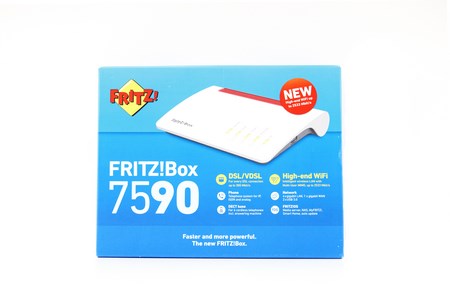 As with every box we've ever received by AVM the a picture of the FRITZ!Box 7590 is placed at the front right next to its main features.
As with every box we've ever received by AVM the a picture of the FRITZ!Box 7590 is placed at the front right next to its main features.
 The benefits of owning this modem/router are printed on the left side.
The benefits of owning this modem/router are printed on the left side.
 Some of the main product features are explained in-depth on the opposite side.
Some of the main product features are explained in-depth on the opposite side.
 The main product features are also listed and explained at the rear of the box in 6 languages.
The main product features are also listed and explained at the rear of the box in 6 languages.
 As always the device is protected by several pieces of cardboard.
As always the device is protected by several pieces of cardboard.
 Inside the box you will find the FRITZ!Box 7590 with its power adapter (white this time over as opposed to black in past models), 1.5 meter long Ethernet cable, two 4 meter long DSL connecting cables (ISDN and analog), two phone line filters/adapters, AVM product catalog and a very detailed quick guide.
Inside the box you will find the FRITZ!Box 7590 with its power adapter (white this time over as opposed to black in past models), 1.5 meter long Ethernet cable, two 4 meter long DSL connecting cables (ISDN and analog), two phone line filters/adapters, AVM product catalog and a very detailed quick guide.
THE FRITZ!BOX 7590 INTERNATIONAL
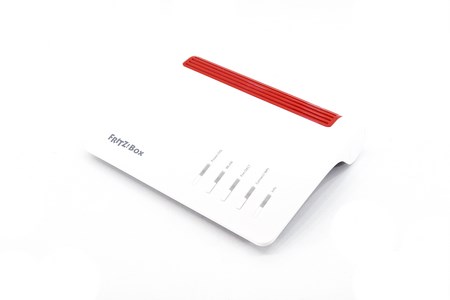 As you can all see AVM moved away from the enclosure design they've been using for many years now and although the new one is still made out of plastic we think it looks more "refined". In terms of size the new enclosure is actually almost identical with the one used with the 7490 model (245x175x55mm) and so it measures 250mm in width, 184mm in depth and 48mm in height.
As you can all see AVM moved away from the enclosure design they've been using for many years now and although the new one is still made out of plastic we think it looks more "refined". In terms of size the new enclosure is actually almost identical with the one used with the 7490 model (245x175x55mm) and so it measures 250mm in width, 184mm in depth and 48mm in height.
The 5 large activity LEDs at the top of the device (power-DSL/wireless Lan/DECT phone/WPS/info) also feature buttons next to them for easier/faster access (compared to previous FRITZ!Box models).
Most of the rear is perforated to allow hot air to exit the interior.

 On the right side of the enclosure we see a TAE-N type connector (German standard) while on the left we see one of the two available USB 3.0 ports.
On the right side of the enclosure we see a TAE-N type connector (German standard) while on the left we see one of the two available USB 3.0 ports.
 At the rear we find 5 RJ45 Gigabit LAN ports, WAN Gigabit port, USB 3.0 port, VDSL port and the analog phone ports.
At the rear we find 5 RJ45 Gigabit LAN ports, WAN Gigabit port, USB 3.0 port, VDSL port and the analog phone ports.
 The bottom is also perforated and has four small rubber feet and two holes for wall mounting.
The bottom is also perforated and has four small rubber feet and two holes for wall mounting.



Once you open the enclosure the large black heatsink placed over the Intel chips steals the show (pretty much). On this side of the PCB we also see the Qualcomm QCA9984 and QCA9985 radios, Litelink CPC5622A module (responsible for the answering machine feature) and the Dialog SC14446 module (responsible for the DECT system).
There are also three MaxBeam High Gain Antennas by Airgain placed on the three out of 4 sides of the unit.
SETUP
After you're done installing the FRITZ!Box 7590 you will just need to launch your Internet browser to start the setup procedure (if that doesn't work automatically then go to http://fritz.box or 192.168.178.1).


The setup wizard will first ask you to choose your preferred language and of course your region.


Next step is to choose your annex mode (A or B), ISP type and assign a password (after which the device will reboot).


Finally the wizard will ask you to choose the type of connection (DSL or Cable) after which it will take a couple of minutes to check your settings and verify the internet connection.
FRITZ!OS 6.83 PART 1
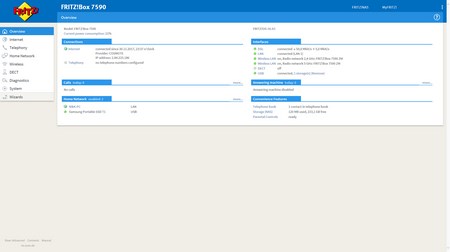
The GUI has remained the same for a while now and so once again the main overview screen includes various details about the device including the current power consumption, OS version, status of connections, available/used interfaces, list of all devices currently connected, audio messages recorded by the answering machine and a quick overview of available features including the telephone book, NAS and parental controls (by default the FRITZ!OS is set on standard view but i strongly suggest using advanced mode from the upper right corner).











Just like with previous FRITZ!Box models via the Internet drop down menu you can check the utilization of your internet connection (there are a couple of nice graphs in the DSL information tab) and the amount of data send and received, setup your connection (IPv6 is supported), set individual parental filters for all connected devices, enable/disable access to the device from anywhere in the world via HTTPS and finally you can monitor your DSL connection from the most detailed information page we’ve ever seen.




From the Telephony drop-down menu you can check the calls list, configure the answering machine, access stored telephone numbers, setup the phone (or phones) as alarms, setup the fax function and also allows you to handle/redirect all incoming calls.
FRITZ!OS 6.83 PART 2
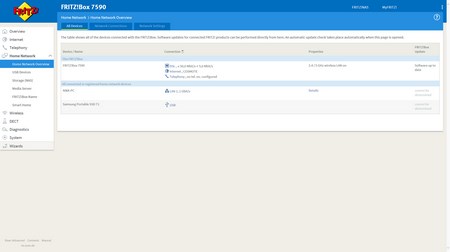


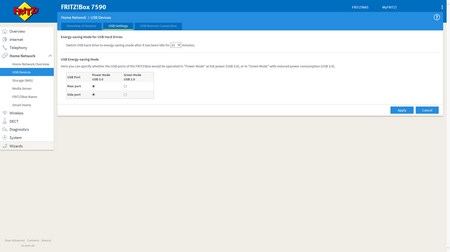


Inside the Home Network drop-down menu you can once again see which devices are connected to the FRITZ!Box (both wired and wirelessly), adjust network settings including the guest access for LAN 4 (perhaps the most important is to enable gigabit connectivity to all ports), check attached USB devices, enable USB 3.0 or USB 2.0 mode for the available ports, enable/disable the onboard memory of the FRITZ!NAS function (you can also configure an external HDD if connected to one of the two USB 3.0 ports) and setup the media server feature.





The WLAN drop-down menu allows the end user to setup the two bands (2.4/5GHz), check and see which devices are connected and how to the FRITZ!Box (wirelessly), monitor the wireless environment to see if something is interfering with the signal, monitor other radio networks in your vicinity, configure the encryption, schedule when you want WiFi to be on and when not, create a guest WiFi access mode and change the operating mode of the unit (access point or repeater).
Although we didn't use the DECT station feature AVM has placed quite a few settings under this tab.


Via the diagnostics page you can run quick diagnostics on both the unit and its security settings.




Checking the event logs, unit power consumption, adjusting the use of the two buttons at the top and the activity LEDs, performing OS updates, backing up all your settings and accessing the NAS function are things you can also do through the System drop-down menu.
TESTING METHODOLOGY
To sufficiently test modem/routers we had to change our methodology quite a bit since we decided to make use of the online internet speed measurement application called SpeedTest (we use it with two different destinations/servers). SpeedTest may not be the most "accurate" way to test internet connection speeds since variables change all the time from our ISP to the ISPs of the servers SpeedTest makes use of but the same can be said for every single way one can test internet speed. Bottom line whatever the results always remember that they may not be 100% on the spot. To somehow "help" our results we also record the connected downstream/upstream values each modem/router is able to get into our charts (reboot the modem/router 6 times to get the average upstream/downstream value).
The rest of our testing methodology involves testing the wireless capabilities of the modem/router at hand and thus it's the exact same we use when testing standalone routers. So once again we will be using the networking benchmark by Passmark (v8), the QCheck by Ixia and ATTO v2.47 (since April 2015). Since we need to test new features and specifications all routers are benchmarked with their highest available wireless standard/band (5GHz in this case). Our systems are outfitted with Kingston HyperX Predator 480GB PCIe SSDs, AC1200 USB 3.0 adapters (we received AC1900 models but so far our results have been somewhat inconclusive in order to replace our AC1200 with them) and CAT7 cables and are placed 15m away from the router with 3 concrete walls between them. Each test is repeated a total of 6 times after which the average scores are recorded into our charts. Both systems now have Windows 10 Pro installed with all the updates until the 1st of December 2017.
We’ve received several requests by some of you to also measure power consumption when testing modem/routers and although differences are not that great between similar models we decided to do so (average power consumption during tests is placed in our charts). Also again after many requests from April 2017 we will also do our best to measure wired USB performance of any modem/router or standalone router that gets to our lab with the help of Crystal Disk Mark v5.1.2 and a Samsung T1 250GB Portable SSD.
TEST RESULTS
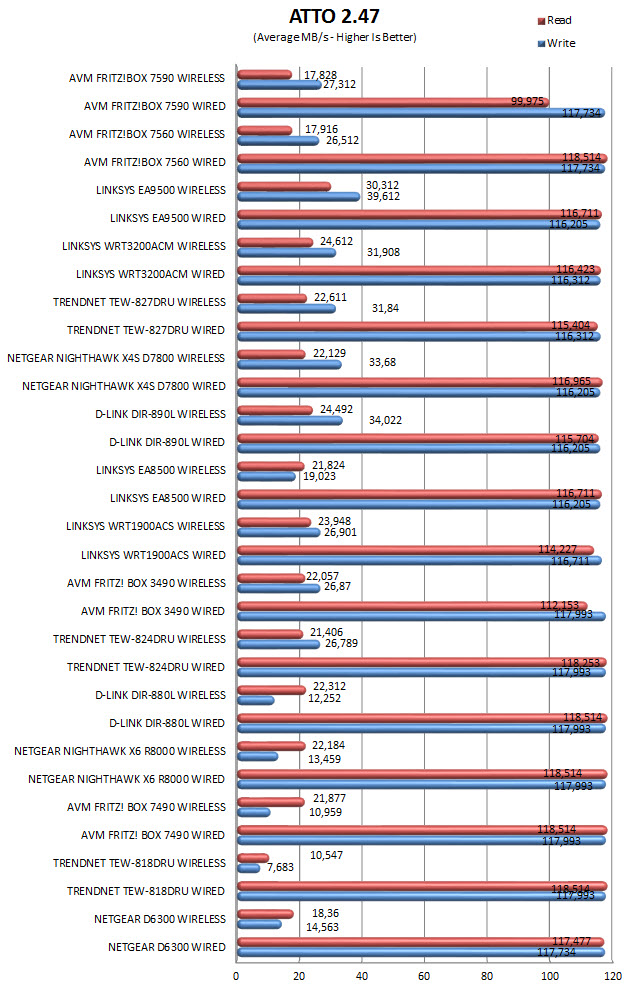


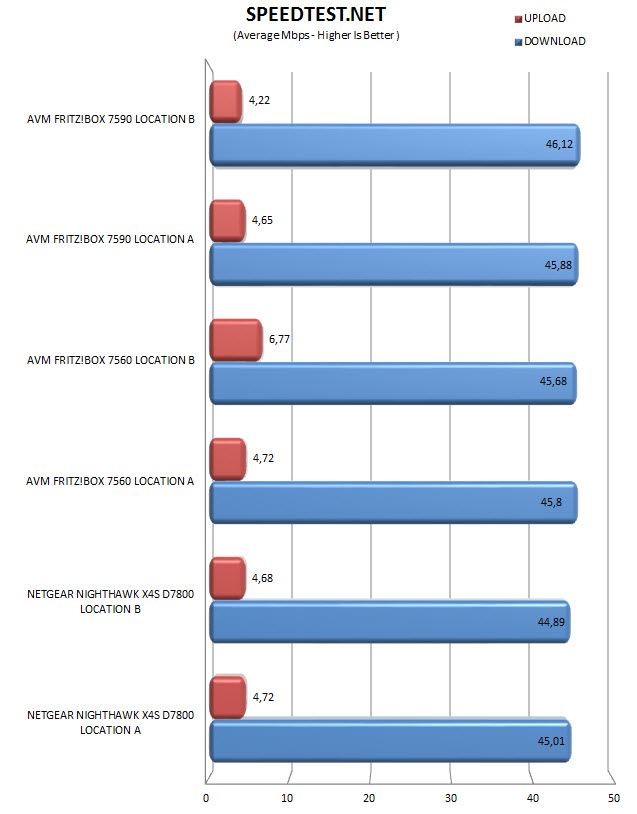



CONCLUSION

AVM is among a handful of network peripheral manufacturers which offer modem/routers (and standalone routers) that feature internal WiFi Antennas and that has always resulted in a wireless performance hit. So with that in mind if you place wireless performance at the top of the things you’re looking for in a modem/router then the FRITZ!Box 7590 may not be for you. The same goes with its USB performance and although it’s slightly improved compared to that of the previously reviewed 7560 model it’s still nowhere close to what we’ve seen from competing products. However what the FRITZ!Box 7590 lacks in terms of wireless and USB performance it more than makes up for that with its long list of features which include support for both Annex A/B and ISDN/IP/analog lines, ability to use as a DECT station with up to 6 cordless telephones, support for super vectoring 35b (300Mbps), intergrated fax with 5 answering machines, NAS and Media server functionality, remote access and support for encrypted communication via VPN.
Although currently the German version of the FRITZ!Box 7590 retails for 269Euros inside the EU (Amazon.de) the international version costs slightly more and can be found between 289-305Euros. That being said even 269Euros for an ADSL/VDSL modem router may seem as a bit much to some but after taking into account all the things offered by the FRITZ!Box 7590 we think that it’s somewhat justified. At the end of the day the FRITZ! Box 7590 is yet another impressive modem/router offered by AVM and although just like its predecessors it fails to impress with its wireless and USB performance numbers thanks to its very long list of features it still deserves our Golden Award.

PROS
- Build Quality
- AC2600 Technology (Concurrent 802.11n 2.4GHz & 802.11ac 5GHz Signals)
- Compatible With All Line Types (Annex A/B & ISDN/IP/Analog)
- Supports Supervectoring 35b
- Available Features (Repeater/NAS Server/Media Server/Answering Machine/DECT Station/IP Telephony)
- Overwhelming Number Of Available Settings
- Android & iOS App
- 2 USB 3.0 Ports
- 4 Gigabit Ethernet Ports
- Dedicated Gigabit WAN Port
- 5 Year Warranty
CONS
- Wireless Performance
- USB Performance
- Price (For Some)

 O-Sense
O-Sense











.png)

